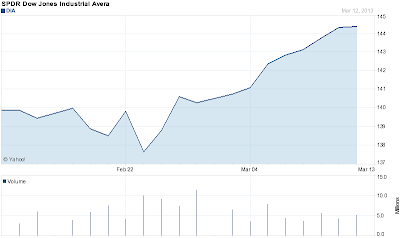America deserves to know what the true rate of unemployment is, and it’s probably a lot higher than the reported rate. The government’s data excludes many Americans who have fallen out of the labor force, and not by choice. Not including these people assumes many have chosen early retirement, but the number of lottery winners hasn’t skyrocketed, so we think it’s more likely that these people have simply fallen off the radar screen. When Americans stop receiving unemployment benefits, their key incentive to report their unemployment to the government is lost. But even as they don’t report as unemployed, they live like they are. In our calculations here, we’ve determined true unemployment is likely 11.8%, not the 7.9% rate just reported by the government. Underemployment is likely closer to 17.9% than the government’s reported U-6 figure of 14.4%.

Our founder earned clients a 23% average annual return over five years as a stock analyst on Wall Street. "The Greek" has written for institutional newsletters, Businessweek, Real Money, Seeking Alpha and others, while also appearing across TV and radio. While writing for Wall Street Greek, Mr. Kaminis presciently warned of the financial crisis.
True Unemployment Rate
Starting with the Reported Data
Nonfarm Payrolls increased by 157,000 on net in January, and private nonfarm payrolls (excluding public sector job creation) grew by 166K, short of the 185K economists’ consensus. The
Unemployment Rate was likewise worse than expected, with the rate increasing to 7.9% from 7.8%, against the economists’ consensus forecast for an improvement to 7.7%. So the employment situation deteriorated in January, and was poor even before adjustment.
Underemployment incorporates people who are not satisfied with their less than full employment and also includes those desperate Americans who are detached from the labor force. However, even the traditional underemployment rate misses what may be a significant number of Americans who are not working and would like to be. To uncover those forgotten Americans, we replace the current labor participation rate with the one that existed when unemployment was under 5.0% instead. It makes sense to use such a participation rate if you believe population growth and the maturing of Americans at least matches the number of seniors retiring by choice and Americans passing away prematurely. Obviously there are demographic trends at play here that may be skewing the participation rate, including the aging of the baby boomers which is costing participation. Still, because of the relevant issue of long-term unemployment in America today and workers falling off the labor force radar screen while still interested in working, I believe these adjusted figures provide an important perspective of the true state of American labor.
Under-Employment
The calculation of the under-employment rate, or the
U-6 by government notation, takes into account the number of Americans working part-time for economic reasons and the detached workforce. Working part-time for economic reasons is equivalent to folks who would prefer full-time employment but have had their hours cut or have had to otherwise settle for part-time work. Detached workers are those Americans who have not recently looked for work, sometimes because they do not believe work exists for them today. In getting to the U-6 underemployment figure, we’ll need to include these groups of workers with unemployed Americans. If we add back the excluded 2.443 million displaced workers to the labor market, and include the 7.973 million underemployed part-timers in the unemployed count, January underemployment is found to be ((12.332M + 2.443M + 7.973M) / (155.654M + 2.443M)) * 100 = 14.4%. In December, the rate was also ((12.206M + 2.614M + 7.918M) / (155.511M + 2.614M)) * 100 = 14.4%.

This data can be skewed by any of its components. Starting with the denominator, the reported labor force count increased in January by 143K, which would dilute the numerator and moderate the unemployment rate. Note also that in January the number of detached workers decreased by 171K and the number of forced part-timers increased by 55K. It’s hard to say whether detached workers disappeared off the radar screen and or got part-time jobs or other work. Most importantly, the number of people reporting unemployed status was up by 126,000; it was also up in December by 164,000. That is an absolutely pure data point marking negative change in the employment situation. The end result of the changes in the component data netted into something less than significant enough to change the underemployment rate, versus the increase in unemployment reported in January.
Historically speaking, U-6 underemployment is improved, as you can see by the table here. However, this improvement may be for another reason (a bad one) which is unaccounted for by this data, and which we discuss in the paragraphs below.
Monthly Period
|
U-6 Unemployment Rate
(Seasonally Adjusted)
|
December 2009
|
17.1%
|
December 2010
|
16.6%
|
December 2011
|
15.2%
|
December 2012
|
14.4%
|
January 2013
|
14.4%
|
What About the Forgotten?
I often talk about the great degree of long-term unemployment plaguing our nation today and how this has uniquely impacted reported employment data. The number of Americans unemployed for 27 weeks or longer was relatively unchanged in January at roughly 4.7 million. This represented 38% of the total unemployed count. The proportion is down from recent history, though it continues to reflect poorly on the state of labor. That’s because the longer people remain unemployed, the harder it gets for them to find jobs in their specialty fields due to eroding and outdated skill sets. I’m concerned that improvement in the proportion of long-term unemployment is partly due to Americans simply falling out of the labor force count rather than finding new work.
For this reason, it’s worth considering what the unemployment rate might be at labor force participation rates seen in the recent past. The labor force participation rate was 63.6% in January 2013. That compares against 66.4% in December 2006. Now, maybe that past participation rate reflected the excesses of the mortgage, construction and finance industries that resulted from greed and the fault of the rating agencies and those industries. Those faults are still bearing out in layoffs, like the significant cuts announced last year by Bank of America (NYSE: BAC) and again late this year by Citigroup (NYSE: C). Still, let’s calculate what the unemployment rate would be at such a participation rate, because if the economy had not been so disrupted by the financial crisis, perhaps those employed in the synthetically fattened fields might have found other work.
Applying the 66.4% rate to the noninstitutional population count in January 2013, we get a civilian labor force count of 162,456,232, versus the 155,654,000 reported (Note calculation error exists because of the seasonal adjustment to the labor force count. I’ve attempted to back into that adjustment and apply it to the theorized labor force count, resulting in this figure for the adjusted labor force: 162,506,691). After that adjustment, the difference from this January’s workforce count is 6,852,691 million Americans who would be added to the unemployed count as well. So if those nearly 7 million Americans have simply fallen off the radar, the true unemployment rate could be as high as 11.8% (not 7.9%), which is up from 11.7% in December 2012. Likewise, the real underemployment rate could be as high as 17.9% today, which is unchanged from December 2012.
Those are significant figures reflecting a poorer state of health for American labor and the economy than the government’s calculations. It’s clear that we need to continue to stimulate job creation in America. Despite much of the recently celebrated economic data, excluding the just reported GDP contraction in Q4 2012, we cannot ignore this fact. Given the message conveyed by the very important GDP and employment reports, an
economic reality check has indeed been served to the nation.
The SPDR S&P 500 (NYSE: SPY), SPDR Dow Jones Industrial Average (NYSE: DIA) and the PowerShares QQQ (Nasdaq: QQQ) have gained approximately 5.1%, 6.1% and 2.7%, respectively, year-to-date through January 2013. Fueled by massive capital flows and the removal of fiscal cliff fear and debt ceiling concerns, gains could continue. However, given these two important economic data points just reported, perhaps capital will be spread out to include lower beta bearing sectors and asset classes. The performance of employment services stocks Friday was mixed to modestly improved, perhaps reflecting the conflicting currents in the market. The shares of several of the nation’s largest employers, however, were decidedly higher, likely on those same capital flow and macroeconomic drivers discussed previously.
Stock
|
Friday’s Change
|
Robert Half Int’l (NYSE: RHI)
|
+0.7%
|
Korn Ferry Int’l (NYSE: KFY)
|
+0.5%
|
Monster Worldwide (NYSE: MWW)
|
-0.2%
|
Manpower (NYSE: MAN)
|
+1.5%
|
Wal-Mart (NYSE: WMT)
|
+0.8%
|
McDonald’s (NYSE: MCD)
|
+0.7%
|
Target (NYSE: TGT)
|
+1.2%
|
Sears (NYSE: SHLD)
|
+1.3%
|
The increase in the flow of
Weekly Initial Jobless Claims last week also offered a reminder to investors who have perhaps overdone the celebration. However, remember that stocks will tend to lead the economy by approximately 6 months. In conclusion, the economic takeaway here should be that America’s unemployment situation could be significantly understated. Fiscal and monetary policy should thus remain supportive of economic growth, and job creation and
small business support should be given highest priority.
Please see our disclosures at the Wall Street Greek website and author bio pages found there. This article and website in no way offers or represents financial or investment advice. Information is provided for entertainment purposes only.
Labels: Economy, Economy-2013-Q1, Editors_Picks, Editors-Picks-2013-Q1, Featured, Featured-2013-Q1, Labor-Market, Labor-Market-2013-Q1, Syndicate
 By Markos N. Kaminis:
By Markos N. Kaminis:

































